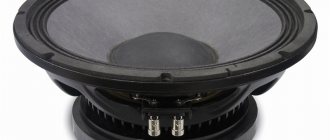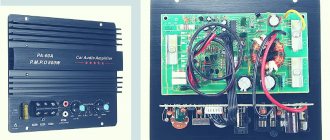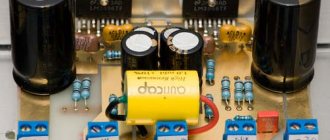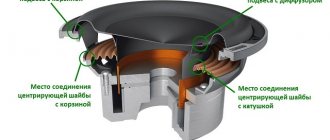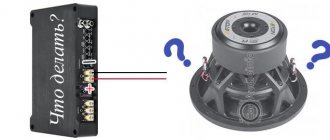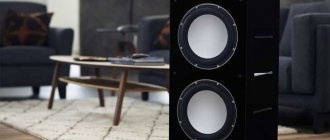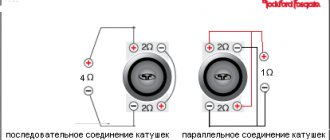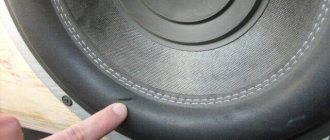How to check a speaker or earphone? It is enough to have the simplest multimeter on hand.
Here are our two patients: earphone and speaker
An earphone is the same small speaker. The speaker structure is shown in the diagram below
In order to check the speaker, we just need to find out if our voice coil is broken? The voice coil is a wire wound in a ring. If the wire is broken, then the speaker is faulty. To check the voice coil, set the multimeter knob to continuity
Let's check the earpiece first. We apply the probes to the earphone contacts and look at the readings of the device.
We see that the multimeter gave us a voltage drop at the ends of the coil of 30 millivolts. Therefore, the voice coil is intact and the earphone is working.
Let's check the loudspeaker speaker. We apply probes to the contacts and look at the readings.
Does it show something? This means the voice coil is intact.
If the voice coil were broken, then the multimeter would show a one on the display.
You can also check the speaker or earphone by setting the knob to measure resistance. Almost every speaker has its impedance value. It is represented by the Ω symbol and is expressed in Ohms. For example, this speaker has a resistance of 8 ohms:
This speaker has a 4 ohm impedance.
Most often, the multimeter will show a resistance of a little more by 1 or 2 ohms.
After checking the coil for an open circuit, you can also check the sound quality of the speaker or headphone. To do this, you need to drive it through all audio frequencies using a frequency generator from 20 Hertz to 20 Kilohertz. If such a speaker produces wheezing and distortion, this is not good. Such a speaker or earphone will do just fine as a sound indicator, but I would advise music lovers to recycle it
In the modern world, speakers have become widespread, because without these devices it is impossible to produce televisions, mobile phones, tablets, speakers, headphones and other audio equipment. And more often than not, their work remains unnoticed by people until the speaker fails.
What is a speaker
A speaker (often called a loudspeaker) is an electrical device that converts an electrical signal into sound. This transformation occurs due to the oscillatory motion of an electric coil in a constant magnetic field (this field is provided by a permanent magnet or, in more rare cases, an electromagnet). This coil moves the diffuser, which in turn creates air vibrations, and this allows you to hear the reproduced sounds.
Despite the simplicity of the design, malfunctions that arise during the operation of the speakers can still occur periodically. If the speaker begins to reproduce sound with interference, hissing or crackling, or stops working altogether, the first step is to localize the problem area.
First, you need to conduct a visual inspection of the device, namely, check for damage:
- housings;
- power cord;
- signal cord;
- corrugations;
- diffuser
If there is damage, this part should be repaired or replaced (if the corrugation or diffuser is damaged, the speaker will have to be replaced). But if no external defects are found, and the sound is reproduced with interference or is absent altogether, then the problem could arise in the contacts or coil of the speaker, and in this case, checking the speaker with a multimeter will help.
Features of online purchasing
Online there is an additional risk of running into a scammer, in order to protect yourself as much as possible and buy a used subwoofer without wasting your nerves, follow the following recommendations:
- purchase goods through advertisements on large, specialized forums. They generally care about the quality of transactions and set trading rules with an emphasis on combating fraud;
- try to purchase equipment from a seller with a good rating, or try to find a guarantor or people who have already made purchases from this person. But it’s not difficult to do this on forums;
- check other threads and messages from the seller;
- ask for additional photographs of the product with the number and name written by hand, if for some reason these were not included in the ad;
- ask for additional photographs from the required angles to visually assess the condition of the case, magnet, suspension, coil, etc.;
- when purchasing for a large amount, there is a practice of a guarantor, when the money is transferred to a third party (a well-known and authoritative person), who gives it to the seller after the buyer confirms receipt of the goods;
- do not hesitate to ask for a photo of the seller’s passport;
- choose a method of money transfers with identification of the recipient (for example, transfers where you need to indicate the recipient’s passport details).
These are the basic security criteria; apply them depending on the riskiness of the transaction.
Checking the speaker with a multimeter
To check the contacts, it is necessary to measure the resistance by setting the multimeter to the mode for determining this characteristic. The probes must be connected to the contacts, observing the polarity of the speaker, and with the diffuser stationary, move them. If the readings on the multimeter display are constantly changing, this will mean that the wiring is damaged and needs to be replaced.
If you turn the speaker over and twist it, you hear extraneous sounds (for example, tapping), then, most likely, several turns or the entire winding have fallen off the sleeve in which the coil is located. This can be corrected by rewinding the winding.
It is also important to carefully examine the voice coil, which is located inside the speaker and looks like a wire wound in a spiral. This coil must have an even, neat winding, without interlacing and random overlaps, kinks, breaks and other mechanical damage. If mechanical defects are still found, the coil should be replaced. You can carefully rewind an incorrect winding (uneven or overlapping) yourself. To check the correct rewinding of the reel, it is enough to listen to two or three well-known songs several times. While listening, you need to focus on volume (both minimum and maximum), sound quality (absence of extraneous noise) and sound transitions.
Rotating the diffuser will also help detect defects. If you hear a grinding, crackling or rustling sound when performing this action, then most likely there are foreign objects near the magnetic gap, for example, scrap metal that accidentally fell during assembly and other debris. This can be fixed simply by cleaning the speaker. If the diffuser turns with difficulty or does not rotate at all, then the problem lies in the displaced coil or sleeve, as well as the displacement of the core, which in turn leads to jamming of the sleeve. This problem can be corrected by disassembling the speaker and installing these parts in the correct position.
The electronics of the speakers can be checked with a tester, ohmmeter or any other device for measuring electrical resistance. To do this, you need to turn the multimeter into resistance measurement mode and measure this characteristic of the speaker. For polyphonic speakers the average resistance is 8 ohms, and for auditory speakers it is about 30 ohms. If the measuring device does not show any data, it means that the speaker wiring is damaged, and if it is intact, then the problem is a broken coil. Damaged wiring or a broken coil must be replaced with new ones.
To check the integrity of the coil itself, you need to ring it using a multimeter. In this mode, the tester probes are connected to the speaker contacts. If the multimeter display shows a value greater than 0, then the voice coil is intact, and if this value is 1, then there is a break in the coil and in this case it must be replaced.
After checking the electronics, it is worth checking the build quality of the diffuser and corrugation. To do this, the speaker must reproduce infra-low frequencies. This will allow you to detect poor-quality gluing of the corrugation and diffuser.
The last thing you should do is check the quality of the speaker using a frequency generator. This speaker test should be performed in the range from 20 Hz to 20 kHz. The absence of wheezing and distortion will mean that the speaker is working properly and efficiently.
How to choose the right track to check
There is no single correct track to check. Everyone can choose for themselves, adhering to the basic rules. The test track must have the highest quality sound version, at least Flac.
The best ones to check are:
- classical music performed by a symphony orchestra, which leads in frequency characteristics and perception;
- albums of instrumental groups (for example, the Swiss group “Yello”, working in the genre of electronic music);
- recordings with sound design;
- classic rock bands (Led Zeppelin, Queen, The Beatles).
Tracks with recordings of such music allow you to check the dynamic range and amplitude-frequency response (AFC).
Attention! Significant criteria for the quality of speakers are the width of the range and clear detail of all sounds.
The test can be done using a professional FSQ test disc. Sound evaluation is based on a subjective statistical method. The disc is intended for professional experts, but is also accessible to experienced listeners. The method includes 15 criteria for assessing sound quality.
How to test a subwoofer without an amplifier
Wait for the search to complete in all databases. Upon completion, a link will appear to access the found materials.
Go to search results >>>
Perhaps the main role in resolving this issue will be played by the choice of amplifier. function is responsible for the quality and power of sound reproduction. At the same time, when purchasing, you should pay attention to the following designations, which mark the introduction of high technologies in the production of audio equipment:
- Hi-fi. Provides maximum purity and accuracy of sound, freeing it from extraneous noise and distortion.
- Hi-end. The choice of a perfectionist who is willing to pay a lot for the pleasure of discerning the smallest nuances of his favorite musical compositions. Hand-assembled equipment is often included in this category.
- Input and output power. The rated output power is of decisive importance, because edge values are often unreliable.
- Frequency range. Varies from 20 to 20000 Hz.
- Nonlinear distortion factor. Everything is simple here - the less the better. The ideal value, according to experts, is 0.1%.
- Signal to noise ratio. Modern technology assumes a value of this indicator over 100 dB, which minimizes extraneous noise when listening.
- Dumping factor. Reflects the output impedance of the amplifier in its relation to the nominal load impedance. In other words, a sufficient damping factor (more than 100) reduces the occurrence of unnecessary vibrations of equipment, etc.
Specifications you should pay attention to:
Classification
To understand the variety of market offers, it is necessary to distinguish the product according to various criteria. Amplifiers can be classified:
- Based on the element base, there are tube, transistor and integrated minds. The latter arose with the goal of combining the advantages and minimizing the disadvantages of the first two, for example, the sound quality of tube amplifiers and the compactness of transistor amplifiers.
- Based on their operating mode, amplifiers are divided into classes. The main classes are A, B, AB. If Class A amplifiers use a lot of power, but produce high-quality sound, Class B amplifiers are exactly the opposite, Class AB seems to be the optimal choice, representing a compromise between signal quality and fairly high efficiency. There are also classes C, D, H and G, which arose with the use of digital technologies. There are also single-cycle and push-pull operating modes of the output stage.
Application
The choice of amplifier is largely justified by the purposes for which it is purchased. We list the main areas of use of audio amplifiers:
- As part of a home audio system. Obviously, the best choice is a tube two-channel single-ended in class A, and the optimal choice can be a three-channel class AB, where one channel is designated for the subwoofer, with the Hi-fi function.
- For car audio system. The most popular are four-channel AB or D class amplifiers, depending on the financial capabilities of the buyer. Cars also require a crossover function for smooth frequency control, allowing frequencies in the high or low range to be cut as needed.
Subwoofer noise
A fairly pressing problem that many motorists have encountered is noise in the subwoofer. When the audio system is turned on, you hear unpleasant noise, which disappears after some time (about 30 minutes), or you have to turn down the volume. Repairing the speaker in this case is possible - you need to check the output of the sound source. Next, check the capacitors of the amplifier power supply. Here the problem may lie in the filter of the amplifier's power supply. Repairing a subwoofer speaker is usually not carried out without adjusting the current stabilization circuit of the output channel, but only when the amplifier operates on discrete elements, and when the radiator is heated to a certain extent, the noise decreases.
Types of faults
Malfunctions are divided into software failures, hardware failures and connection problems. The latter include: incorrectly inserted or fallen out plug, plug, lack of power supply, etc.
Software
The reason is that a working sound card is not processing or transmitting data correctly. This may be due to the lack of a driver or its incorrect operation. You need to go to the official website of the sound card manufacturer and download the latest version. If, on the contrary, the devices stop functioning after the update, you should install the previous version of the driver, which is also available on the official website.
Hardware
The problem is the failure of one or more elements of the device. It could be a speaker, transformer, switch, etc. To find the breakdown, you need to carry out diagnostics. To do this, first eliminate the most easily fixable failures, and then check all the elements using a multimeter.
Basic breakdowns that you can fix yourself
First, it is necessary to make a primary diagnosis. Try to connect the speakers to a 220V power supply. If we are talking about additional speakers from a laptop, then you need to connect the power via USB. The illuminated operation indication LED may indirectly indicate the operability of the UMZCH power circuits.
Second, try touching the end of the 3.5mm stereo plug with the most common diagnostic tool - your finger. For working speakers, such a touch should cause a serious hum of 50 Hz interference. The hum should be pronounced. If there is no such background, then this indicates either a violation of the integrity of the audio wire, or a breakdown of the 3.5 mm plug, or a failure of the UMZCH. Moreover, the UMZCH - audio frequency power amplifier fails extremely rarely; first of all, check the wires and plug.
Causes of failure
It is important to know the reasons in order to make a decision about the advisability of repairs and prevent a similar problem from occurring in the future.
The most common reasons are:
- natural wear and tear of structural elements. Failed elements must be replaced with new ones. If all suitable spare parts are available, the life of the equipment can be extended as long as desired. The body is the last to wear out, but it can also be replaced;
- voltage drops in the network. To protect devices, you need to connect them through an individual computer power supply. Another option is to choose devices with a high-quality fuse when purchasing. This element is easiest to replace if the device suffers from a power surge;
- cable damage - devices do not receive power from the network and therefore do not work. Can I replace the wire myself? Yes. How easy it will be to do this depends on the design of the speakers;
- malfunction or incorrect operation of the computer sound card. If the card is faulty, it will have to be replaced. If it does not function correctly, you need to update its drivers or roll them back;
- violation of operating rules. Speakers do not like high humidity and sudden temperature changes. Of course, high-quality equipment has a margin of safety, but it will last long only if the manufacturer’s recommendations are followed;
- low quality or manufacturing defect. It’s not worth buying a cheap “knee” assembly. However, even expensive ones may turn out to be “garage-made”. Conclusion: you need to buy products from reputable brands and do it in stores that have been operating on the market for a long time. In this case, defects are rare; if this happens, they will be replaced without any problems or quickly repaired in a warranty workshop.
Checking the functionality of the speakers
An out-of-the-box speaker system, assembled correctly, should reproduce sound from any external source. The best way to check functionality is to connect two or more devices in turn.
Since we will connect them to the computer, we already have one source. As a second one, you can use a mobile phone or tablet: almost all such devices are equipped with a slot for a 3.5 mm jack.
If the speakers are turned on and all wires are connected correctly, but there is no sound from any source, the problem is in the speaker system. We pack them back, take them to the store, argue for a long time with the seller, carry out an exchange or return. Just a joke, of course, it’s best to be polite, and the result will be and the target’s nerves will remain.)
Popular faults
There are several common types of faults (for example, rear exit). Some of them can be fixed on your own. To do this, you first need to understand what happened. It is not always possible to visually find a breakdown, so you should pay attention to the symptoms - characteristic signs of each type of failure.
Damage to the wire near the plug
If the cord is frequently kinked, its conductive core may be damaged. The devices will be unconnected and will not work. The weakest points are near the plug and near the body, next to hard elements.
You need to inspect the wire and try to change its position several times. If the sound appears and disappears, it means that the faulty element has been detected. Sometimes straightening the cord is enough, but most likely you will have to replace it with a new one.
Speaker failure
A relatively rare malfunction, but the possibility of this breakdown should not be discounted.
To verify the functionality of this part of the structure, you need to “ring” it with a multimeter. The speaker housing indicates the nominal impedance. If the measurement result differs from the nominal value, the cause of the non-operating condition is the speaker. It needs to be replaced.
How to replace wire and plug
Let’s immediately make a reservation that you need to buy a plug and wire for stereo audio systems, that is, the sound should be divided into 2 channels. In order for us to fully enjoy surround sound, the sound is supplied to the amplifier input not through 2 wires, but through four. The plug is also made using stereophonic technology. When choosing a plug, ask the seller for one with 3 outputs: 1 – common wire, 2 – first phase (right channel), 3 – second phase (left channel). A 3.5 mm monophonic plug is not suitable for our purposes, since there are only 2 contacts: 1 – common wire, 2 – phase (monaural signal). The wire must be either three or four wires. In a four-wire arrangement we have two separate lines of common wires and 2 separate phases, and in a three-wire arrangement we have 1 common ground and 2 separate phases. The two-wire circuit is unsuitable for our purposes. All wires are connected to the plug using soldering. No twists work reliably here.
The stages of termination and soldering of the cable to the plug are shown in the photographs.
Repair recommendations
The general rule is to start with simple actions. It makes sense to open the case, check the circuit with a multimeter and look for the failed element after external causes have been completely ruled out.
The devices may be working properly, but there is no sound due, for example, to the fact that the plug has fallen out of the socket;
- If everything worked fine and the sound suddenly disappeared, check all connections: plugs, plug. If there is a connection to a plugged-in laptop, make sure there is electricity. The laptop runs on battery power, and you may not immediately notice that there is no light;
- If the indicator lights up properly, indicating that they are on, but there is no sound, check the volume control. It may be set to minimum and that's why you can't hear the quiet audio;
- If one speaker sounds and the other does not, check the sound settings on your computer. The balance slider should not be strongly shifted in any direction; its normal position is in the middle of the scale;
- Check if the headphones and, preferably, the microphone connected to the computer are working. If both of these devices function normally, the problem really lies in the speaker system;
- connect the devices to your phone or player. If they work, this means that the problem is not with them, but with the computer’s sound card or software;
- If there is noise, make sure the plug is inserted into the correct socket. You also need to check if the settings have gone wrong;
- The noise may also be a result of speaker damage. It is necessary to check its integrity after the reasons described in the previous paragraph have been excluded;
- You can check the speaker without a multimeter, but if the problem turns out not to be the speaker, it will be difficult to move on without this measuring tool;
- To test the speaker, connect its contacts to a regular 1.5 V battery, plus to plus, minus to minus. If the speaker is working properly, you will hear a rustling sound and notice a slight shift in the diaphragm;
- when it becomes clear that the problem lies in the hardware of the speakers, you need to “ring” the circuit with a multimeter and find the failed element;
- During repairs, wires should only be connected by soldering. You can't just twist them or use terminals;
- All wire connections must be insulated; you can use electrical tape.
It's not clear how he plays
In stereo systems, the sound from the right and left speakers is usually slightly different. However, if they are installed next to each other or at a close distance from each other, it may not be immediately clear that one of them is not working. To check the performance of each column separately, you can use the standard Windows test.
Right-click on the speaker icon in the system tray and select “Playback Devices” from the context menu. Find your default speakers, highlight them, and click the “Customize” button located in the lower left corner of the dialog box.
In the window that opens, click the check button. You will hear a test beeping sound - first in the left, then in the right speaker. If one of them does not work, it will be immediately noticeable. A “skew” of the balance will also be noticeable if it is set incorrectly.
To adjust the balance, click on the speakers you are using in the “sound” dialog box and click the “Properties” button in the lower right corner. In the window that opens, go to the “Levels” tab and click the “Balance” button Opposite the topmost item.
Another small window will open in which the volume parameters of each channel are indicated as a percentage.
Important! If the sliders are set evenly, but there is still a certain skew, then the problem is in one of the speakers - perhaps, if it is a multi-channel audio system, one of the speakers has failed, so the overall “chorus” sounds quieter than the speaker on the other side.
And just in case, I also advise you to read the publication “Sound speakers - what are they: how do they work and their functions.”
How to check if the speakers are working on your computer
Properly functioning devices produce clear sound with clearly distinguishable tones and minimal distortion. There should be no noise, crackling, or metallic “impurities”, including at minimum and maximum volume. To check the sound quality, you need to listen to both music and speech through them, and then draw conclusions.
The audio system must respond correctly to changes in settings. It is necessary to check not only the software volume control, but also all other parameters.
So, it is not difficult to repair the equipment. The most that needs to be done is to find a spare part and install it in place of the failed element. In cheap low-quality audio speakers, the weak link is usually the transformer. A suitable one can be purchased at almost any radio parts store.
Expensive professional speakers that are equipped with sound processing systems are more difficult to understand. Before you begin repairs, you need to find a diagram of this or a similar device. The malfunction of such equipment may be due to wear on the speaker or failure of the capacitor.
Please note that expensive high-quality speakers from reputable manufacturers usually have a fairly long warranty. If its period has not expired, you need to contact the warranty center. There the fault will be fixed or the device will be replaced with a new one.
This article will be of interest to you when such a moment comes and your computer does not turn on.
Checking for correct connection
So, the device has been tested for functionality, it works, delighting with rich sound, but the computer does not play anything. The next thing to do is check that the device is connected correctly.
I remind those who forgot: the speaker system is always connected to the green slot on the computer or the jack marked with the image of the speaker on the laptop. If you have a sophisticated stereo system with many satellites and subwoofers, the sockets are marked with the following colors:
- Orange – central monitor or subwoofer;
- Black – rear speakers;
- Gray – side satellites;
- Green – front satellites.
The red jack is always used to connect a microphone. Blue is the line input to which all other external sound sources are connected.
I also remind you that the detachable RCA cable to the speaker system should always be connected according to the color of the socket and plug: red to red, white to white.
Signs of amplifier failure and necessary repairs
Car audio remains a complex system in which the amplifier is far from the main component.
Almost any malfunction leads to the fact that the speakers begin to reproduce not pure sound, but hissing, interruption of the melody, grinding, etc. Experts identify several characteristic signs by which it can be determined that it is the amplifier that has failed. When the motor is inactive, the amplifying unit receives a voltage within 12 V and up to 14.5 when the engine is running. If in any position of the engine there is no voltage supply to the amplifier, while the wires are intact and the terminals are not oxidized, the functionality of the generator is checked.
Can tweeters be connected to an amplifier?
Tweeters
with a rated power of 3-10 W, car radios with a rated power of 12-22 W are “pleased” to connect to the built-in
amplifier
and play with no worse quality than with an external amplifier, of course, unless you are an audiophile listening in the forest with the engine turned off.
Interesting materials:
How to find out the set-top box ID? How to find out the ID of a Smart Baby watch? How to find out the id of a smart watch? How to find out the ID of a smart card? How to find out your Steam ID? How to find out information about RAM? How to find out information about your RAM? How to find out how you are on Skype? How can I find out what kind of RAM I have? How to find out what RAM?
